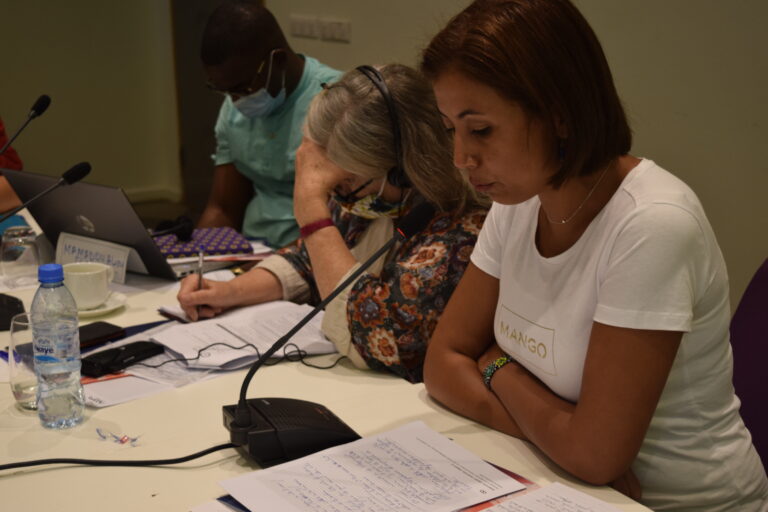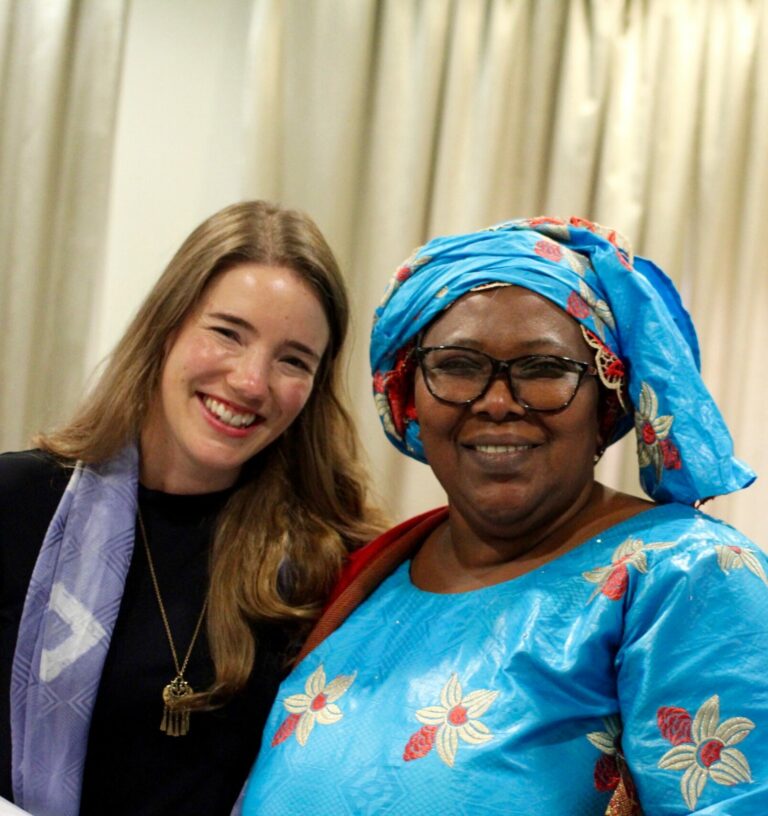The Media and Transitional Justice Academy

GIJTR’s work in conflict and post-conflict countries has shown that journalists and members of the media, although often overlooked in conflict and the ensuing transitional justice processes, play a crucial role—either as instigators or provokers of conflict, or as key players in raising awareness, putting information about the conflict or the transitional process in the public domain and sharing survivors’ stories to support their recognition and broader societal healing. However, despite the significance of their role, journalists and media personnel often do not have sufficient training in relation to atrocity prevention and transitional justice.
To address this gap in programming, Consortium partners worked on a twelve-month Media and Transitional Justice Academy (the Media & TJ Academy) to promote and address the critical role that traditional and citizen journalists play in sparking dialogic engagement on key transitional justice and atrocity prevention concepts. In this interview, Sarah Case, project manager of the Media & TJ Academy, shares details of the programming for this project.
Since its launch in 2014, the Global Initiative for Justice, Truth and Reconciliation has developed a variety of academies, including the Forensics Academy and the Middle East and North Africa (MENA) Transitional Justice Academy, which empower activists, academics and other stakeholders to raise awareness of issues related to memory, truth, justice and reconciliation in a given context. In 2022, the GIJTR launched the Media and Transitional Justice Academy, which built the capacity of journalists working on topics related to truth and atrocity prevention. As the program director for this initiative, Sarah Case tell us how and why this academy came about and its outcomes.
SC: Through our work at the GIJTR, we’ve observed that journalists and members of the media can play a vital role in advancing transitional justice goals and contributing to atrocity prevention. The stories they share, whether through more traditional news outlets or newer multimedia platforms, can raise awareness about transitional justice processes and ways for people to engage with them, combat misinformation and hate speech, and share survivors’ stories to support their recognition and a nuanced understanding of past human rights violations. At the same time, journalists often do not have access to any kind of training in transitional justice or atrocity prevention, which, at the formal level, can sometimes seem like top-down processes with little relation to people’s everyday lives and concerns in the aftermath of conflict. Our goal with the Media and Transitional Justice Academy was to address this information gap by offering journalists a capacity-building program on transitional justice, atrocity prevention and media that allowed them to build a baseline knowledge in these fields while highlighting the wide array of programs and actors that can support truth-telling, justice and remembrance at both the national and grassroots levels. In addition to participating in workshops and exchanging learnings with colleagues from other contexts, GIJTR partners offered mentorship and financial support for the participants to develop innovative, pilot projects that allow them to put the knowledge they’ve gained directly into practice and respond to pressing truth, justice and violence prevention needs in their home countries.
The Academy opened for applications to journalists from Algeria, Côte d’Ivoire, The Gambia, Guinea, Morocco, Nepal, Sri Lanka, South Sudan, Sudan, Timor-Leste, and/or Tunisia. Why were these countries selected for this specific project?
SC: The project partners had a difficult time choosing which contexts to include, as we’ve observed an interest in this type of training across multiple countries and regions! Ultimately, we wanted to promote cross-regional exchange on media, transitional justice and atrocity prevention, while being mindful of potential language barriers and the budgetary and logistical implications for including interpretation and translation for more than two languages in the program. We thought that it would be interesting and useful to include participants from countries at different stages in relation to transitional justice processes–some still in a period of conflict or transition, others with formal transitional justice processes ongoing, and others where transitional justice processes have concluded–and we selected these specific contexts based on a stated interest from our local partner organizations in this subject. One of our goals within the Academy was to support multi-directional learning, as we recognize the vast expertise of our participants and their knowledge of the communities they support. While the GIJTR partners offered feedback to the participants as they implement their sub-grant projects, we encouraged the participants themselves to form a network of support and inspiration, challenging each other’s ideas and sharing resources that help to advance their shared goals.
Thanks to technological advances, the role of media has evolved significantly in the last few years. Today, news and information are rapidly shared across borders, reaching hundreds of thousands of people in seconds. However, this growth has become a double-edged sword with fake news and propaganda used to manipulate citizens and support authoritarian governments. How did the Academy address this issue, particularly considering that some candidates come from countries actively experiencing conflict or working in repressive settings?
SC: While much of the program focused on the positive potential of journalism and the media in relation to transitional justice and atrocity prevention, it is equally important that we recognize the destructive power of these mediums in provoking conflict. As we’ve seen in contexts like Rwanda and Myanmar, the media can be used to spread hate speech and fuel anger and resentment against minority and marginalized populations, ultimately leading to the outbreak of conflict and human rights violations. The Academy actively addressed these issues by inviting experts from within our network of global member sites and journalists working in other contexts to share practical strategies they have used to combat hate speech and the spread of misinformation. Participants were encouraged to reflect on similar needs in their own contexts and develop their own strategies, through their sub-grant projects, to counter misinformation with fact-based, engaging and thoughtful storytelling. Their reflections and the lessons learned from the implementation of their projects were incorporated into a series of recommendations on journalism, transitional justice atrocity prevention that contributed to our growing knowledge on this issue.
Following up on the previous question, social media has become a crucial tool for disseminating news and information in a lesser time. Independent journalists, media outlets, and human rights activists have taken platforms like Tik Tok, Twitter, Instagram, and others to report human rights violations and call out perpetrators. Did the Academy focus on these new trends? Why or why not?
SC: Absolutely–we believe it is important to engage journalists working across a wide variety of different platforms, particularly as different types of media and reporting techniques are necessary to reach different audiences across different contexts. We recognize that there is no one-size-fits all approach and that, as journalists and transitional justice practitioners, we must continue exploring new tools and building our skills to engage new groups. Through our work in countries emerging from conflict, we’ve witnessed the power and potential impact of creative, arts-based and survivor-focused media projects, whether it’s a short video that helps the public to better understand the need for a reparations program; a social media campaign that galvanizes youth to combat hate speech in their schools; or a documentary photo exhibition that gives survivors a platform to share their stories, contributing to remembrance and societal healing. We explored the pros and cons of these different platforms and types of media through the Academy, helping participants to decide which may be best-suited to their project goals.
Apart from what you have mentioned above, what other themes did the Academy focus on? And how, when and where did trainings take place?
SC: A portion of the curriculum was finalized based on input from the participants. However, some of the key topics that we planned to address were psychosocial support and trauma-informed reporting, digital and physical security (for both the journalists and their interviewees), the responsibility that comes with sharing survivors’ stories, dealing with contested narratives in conflict and post-conflict societies, the use of documentation in international accountability mechanisms, creating media for memorialization purposes, and the role of journalists in framing and monitoring transitional justice processes. The Academy adopted a hybrid model, with sessions taking place both online and in-person. We planned to make use of lessons from the last two years to organize a virtual training session, where we invited expert speakers who might not be able to attend a workshop in-person. We then organized an in-person training in Conakry, Guinea, in August to support networking and trust-building among the participants. We concluded the program with a final virtual evaluation and reflection meeting, during which the participants shared the results of their pilot projects and reflect on broader learnings that can be drawn from their experiences and incorporated into a set of recommendations to be shared with journalists in other contexts.

Sarah Case
Sarah is currently a Deputy Program Director for the GIJTR. She has managed a range of projects, including a Transitional Justice Academy for activists in the MENA region; a multi-year collaboration with Guinean civil society organizations to advance community memorialization, psychosocial support, and violence prevention; the development of a manual and resource center on digital archiving for civil society organizations; and a research and exchange project aimed at highlighting the unique needs of survivors conflict-related sexual violence and their children within transitional justice processes.
